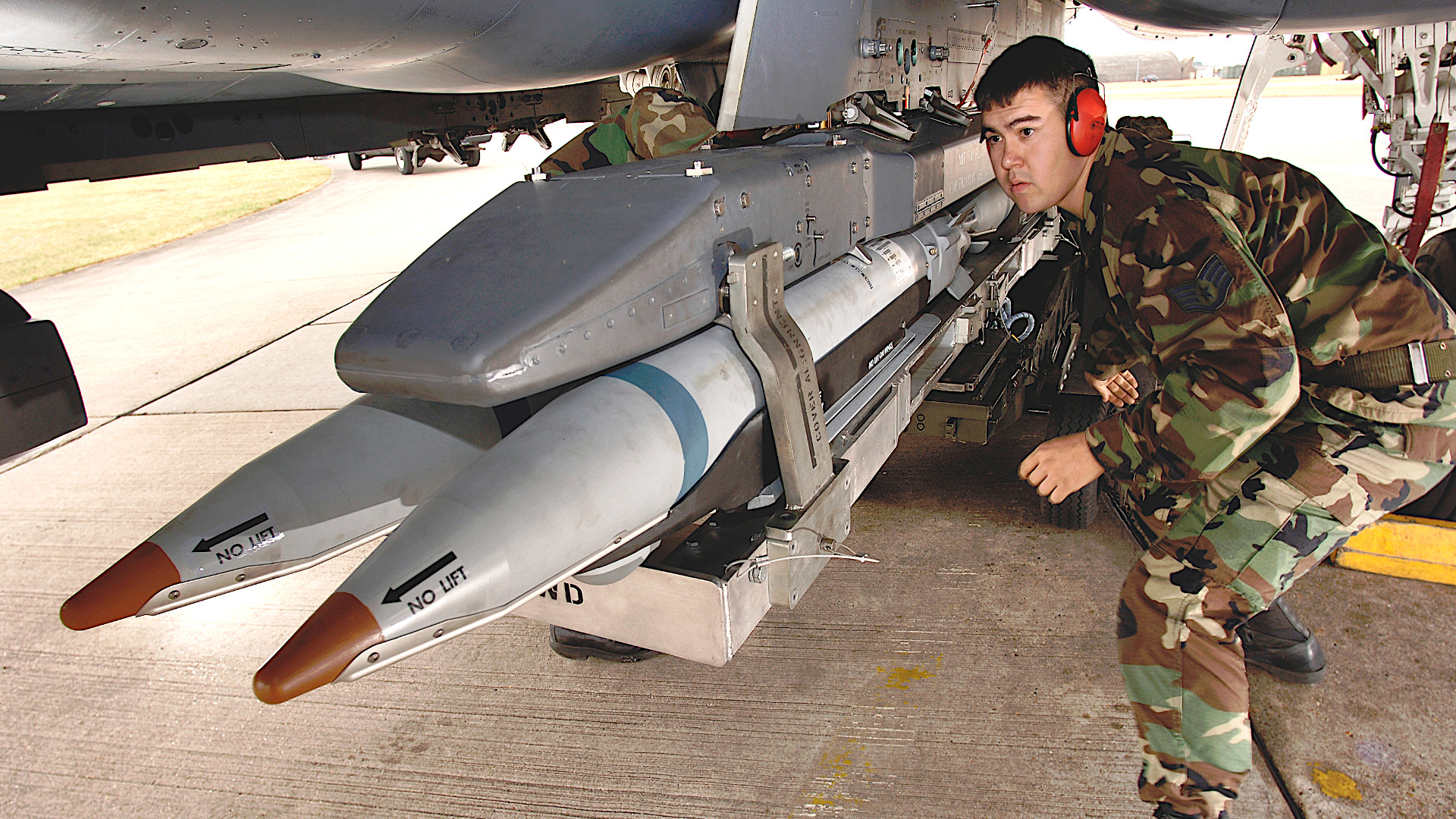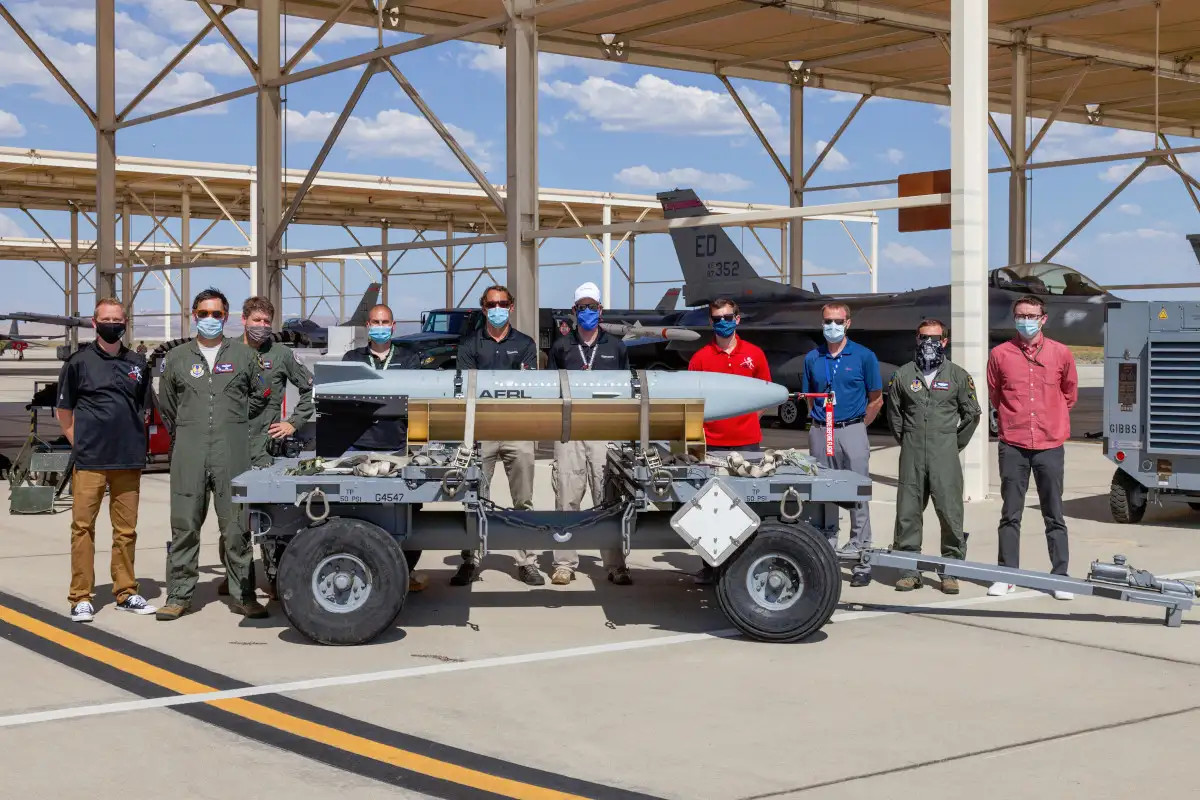The Air Force has dropped Small Diameter Bombs modified to incorporate swarming technology as part of the service’s Golden Horde program for the first time. The ultimate aim of this effort is to develop artificial intelligence-driven systems that could allow the networking together of various types of precision munitions into an autonomous swarm.
The test, which took place on Dec. 15, 2020, but which was only publicly announced today, was carried out by a team from the U.S. Air Force Test Center at Eglin Air Force Base in Florida using an F-16 Viper fighter jet from that base’s 96th Test Wing. The aircraft dropped two specially-configured Collaborative Small Diameter Bombs (CSDB) during the experiment.

“The Golden Horde demonstration with the Small Diameter Bomb flights is an important step on the path to Networked Collaborative Weapon systems,” Chris Ristich, Director of AFRL’s Transformational Capabilities Office, said. “Completion of this first mission sets the stage for further development and transition to the warfighter.”
The Air Force Research Laboratory (AFRL) is overseeing the Golden Horde program, with Scientific Applications & Research Associates, Inc. (SARA) under contract to develop the actual technology underpinning the effort.
The CSDBs appear to be modified versions of the GBU-39B/B Laser Small Diameter Bomb (LSDB), with the laser seeker of that weapon replaced by a new nose section with the Golden Horde technology. The standard LSDB also has the same GPS-assisted Inertial Navigation System (INS) guidance option as the standard SDB. After the F-16 released the two test bombs, they “quickly established communication with each other and their seekers detected a GPS jammer,” according to AFRL.

The GPS jammer was one of a number of potential targets that had been arrayed on the test range. The official Air Force news item on the test described the full mission as such:
During the mission, the weapons referred to pre-defined Rules of Engagement (RoEs), a set of constraints preloaded by a mission planner, and determined that the jammer was not the highest priority target. The weapons then collaborated to identify the two highest priority targets. However, due to an improper weapon software load, the collaboration guidance commands were not sent to the weapon navigation system. Without the updated target locations, the weapons impacted a fail-safe target location.
So, while not a complete success, in that the weapons failed to impact the simulated high-priority targets, the test nonetheless provided the first practical evaluation of the Golden Horde program. Another two CSDB flight tests are planned for early this year, ultimately employing four rather than two collaborative weapons in each mission.
“I’m very pleased with the results of this first test,” said Steven Stockbridge, the Golden Horde Principal Investigator. “The team saw a good performance from the networked collaborative sub-systems and understand the root cause of the weapons not impacting the desired targets. We anticipate readiness for the next flight test.”
Golden Horde is focused on developing what the Air Force is calling “networked, collaborative, and autonomous” weapon capabilities, or NCA, and will involve both live and virtual testing. Ultimately, the plan is to field NCA-enabled weapons that will be able to share information and work together collaboratively in a swarm to best overwhelm hostile air defenses and make it to their otherwise intended targets. This requires the weapons not only to “talk” to each other, but also to sense and react to changes in the battlespace in real-time.

In this first test, the NCA package inside the CSDBs included “a home-on-GPS-jam seeker that gathers information about the battlespace, a software-defined radio for communication between weapons, and a processor preloaded with collaborative algorithms,” according to the Air Force. The service compares the collaborative algorithms used in the NCA concept to a quarterback calling a play in football.
Each “play” relates to an established behavior for a swarm of collaborative weapons, depending on the conditions in which they find themselves. Since the weapons use autonomous technology, their responses will only be in line with those prescribed in the preloaded algorithms, or “list of plays.” This kind of capability sounds very similar to what Boeing demonstrated with its Decision Mission-Control Software (DICE) during testing of the X-45A unmanned aircraft nearly two decades ago, which you can read about more in this past War Zone feature.
It’s also interesting to note that the “home-on-GPS-jam seeker” used in the CSDBs would seem to imply the existence of a previously undisclosed anti-radiation version of the GBU-39/B with a guidance system capable of zeroing in on a target radio-frequency emissions. If this SDB variant doesn’t already exist, this would certainly make clear that it is a viable future guidance option for the weapon.
“This successful Golden Horde demonstration builds the foundation for integrating this technology into a variety of other weapon systems, which will help the U.S. maintain a technological advantage over our adversaries,” said Air Force Colonel Garry Haase, Director of AFRL’s Munitions Directorate.
While the Air Force doesn’t appear to have any present plans to field the CSDBs themselves as operational weapons, further developments of the technology that it is now trialing as part of the Golden Horde program could well find its way into frontline weapons. The AGM-158 Joint Air-to-Surface Standoff Missile (JASSM), as well as the ADM-160 Miniature Air-Launched Decoy, have both been mentioned in the past as potential candidates for this swarming technology.

Networked together in a swarm, cruise missiles, such as the AGM-158, could engage targets across a broad area more effectively, prioritizing targets in real-time and even accounting for ones that suddenly emerge, such as pop-up air defense threats, while they’re in flight. As well as the increased capability to destroy targets more efficiently, the technology being developed under Golden Horde could potentially allow weapons to be launched into a general area without a specific target or targets identified in advance.
This same kind of real-time prioritization would be immensely valuable for decoys, such as the ADM-160, or air-launched stores capable of non-kinetic attacks, including ones carrying electronic warfare jammers. A better understanding of the battlepsace through networking would also simply help autonomous weapons cover a designated area in the most efficient manner within pre-programmed mission perameters.

The Golden Horde technology could also provide particularly impressive effects when combined with munitions, such as the GBU-53/B StormBreaker, previously known as the Small Diameter Bomb II, that feature multi-mode targeting systems. Weapons with multi-mode seekers are already immensely flexible against a wide variety of targets, including ones in motion, in various kinds of environments. A networked swarm with these capabilities would therefore have even more ways to find targets and determine the best way to sort and engage them.

In 2019, the Air Force also notably announced that it was canceling its Gray Wolf program, which had been focused on the development of technology to support the development of a low-cost cruise missile, in order to refocus those resources into Golden Horde. At the same time, the service said that the initial phases of Gray Wolf had also been used to explore networked munition concepts and that it would leverage at least some of the work done under that project to support Golden Horde.
The development of advanced, but low-cost munitions is a key tangential requirement to ensure that future expendable weapons swarms do not become prohibitively expensive. Though the Gray Wolf program has been curtailed, the Air Force has still been separately working toward a live-fire test of the experimental missile design that the project had produced.

All of this could help produce families of “smarter” and cheaper weapons that could also help further reduce the risk to the launching aircraft compared to the kind of precision-guided weapons available today by giving more authority to the munitions themselves to find and engage targets. Tactics wise, having the actual weapons work together to attack certain target sets autonomously could drastically increase their effectiveness, especially in highly defended airspace.
As it stands now, the Air Force plans to conduct at least two more CSDB flight tests early this year. The goal is for at least one of these tests to involve the release of four of the weapons, rather than just two.
This recent test of the first CSDBs already represents an important step forward in the development of exciting new air-launched swarming munitions capabilities that have the potential to totally change how aerial warfare is waged.
Contact the author: thomas@thedrive.com
